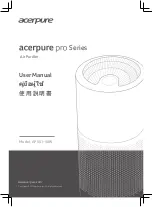
18
IM 861
9
Remove the screws (3) connecting the divider plate to the
heat exchanger center panel.
10
Remove the turbulators from inside the heat exchangers by
inserting the blade of a screwdriver under the locking tabs.
Pop the tabs out of the expanded grooves of the heat
exchanger. Slide the turbulators out of the heat
exchangers.
11
Direct a water hose into the outlet of the heat exchanger
top. Flush the inside of each heat exchanger tube with
water. Blow out each tube with air to remove excessive
moisture.
12
Reassemble (steps 1 through 10 in reverse order).
Be
careful not to strip out the screw holes used to mount
the collector box and inducer blower. Replace inducer
blower gasket and collector box gasket with factory
replacements if damaged.
The manufacturer recommends that a qualified installer,
service agency or the gas supplier visually inspect the burner
flames for the desired flame appearance at the beginning of
the heating season and approximately midway in heating
season.
The manufacturer also recommends that a qualified installer,
service agency or the gas supplier clean the flame sensor with
steel wool at the beginning of the heating season.
Lubrication
IMPORTANT: DO NOT
attempt to lubricate the bearings on the
blower motor or the induced draft blower motor. Addition of
lubricants can reduce the motor life and void the warranty.
The blower motor and induced draft blower motor are
prelubricated by the manufacturer and do not require further
attention.
A qualified installer, service agency or the gas supplier must
periodically clean the motors to prevent the possibility of
overheating due to an accumulation of dust and dirt on the
windings or on the motor exterior. And, as suggested
elsewhere in these instructions, the air filters should be kept
clean because dirty filters can restrict air flow and the motor
depends upon sufficient air flowing across and through it to
prevent overheating.
Cooling Section
Maintenance
It is recommended that at the beginning of each cooling
season a qualified installer or service agency inspect and clean
the cooling section of this unit. The following areas should be
addressed: evaporator coil. condenser coil, condenser fan
motor and venturi area.
To inspect the evaporator coil:
1
Remove the filter access panel and the blower/evaporator
coil access panel. Remove the filters
2
Shine a flashlight on the evaporator coil (both sides) and
inspect for accumulation of lint, insulation, etc.
3
If coil requires cleaning, follow the steps shown below.
Cleaning Evaporator Coil
1
The coil should be cleaned when it is dry. If the coil is
coated with dirt or lint, vacuum it with a soft brush
attachment. Be careful not to bend the coil fins.
2
If the coil is coated with oil or grease, clean it with a mild
detergent-and-water solution. Rinse the coil thoroughly
with water.
IMPORTANT: Do not
use excessive water
pressure. Excessive water pressure can bend the fins and
tubing of the coil and lead to inadequate unit performance.
Be careful not to splash water excessively into unit.
3
Inspect the drain pan and condensate drain at the same
time the evaporator coil is checked. Clean the drain pan by
flushing with water and removing any matters of
obstructions which may be present.
4
Go to next section for cleaning the condenser coil.
Cleaning Condenser Coil, Condenser Fan,
Circulation Air Blower and Venturi
1
Remove the compressor access panel. Disconnect the
wires to the condenser fan motor in the control box (see
wiring diagram). Remove the wires from the opening in
the bottom of the control box.
2
Remove the screws securing the condenser top panel and
remove the panel with condenser fan motor and grille
attached.
Holes in the exhaust transition or heat exchanger can cause
toxic fumes to enter the home. The exhaust transition or
heat exchanger must be replaced if they have holes or
cracks in them. Failure to do so can cause carbon
monoxide poisoning resulting in personal injury or death.
▲
▲
DANGER
!
Disconnect main electrical power to the unit before
attempting maintenance. Failure to do so may result in
electrical shock or severe personal injury or death.
▲
▲
DANGER
!
Disconnect main electrical power to the unit before
attempting maintenance. Failure to do so can cause
electrical shock resulting in severe personal injury or death.
▲
▲
DANGER
!
Label all wires prior to disconnection when servicing the
unit. Wiring errors can cause improper and dangerous
operation resulting in fire, electrical shock, property
damage, severe personal injury or death.
▲
▲
DANGER
!















































